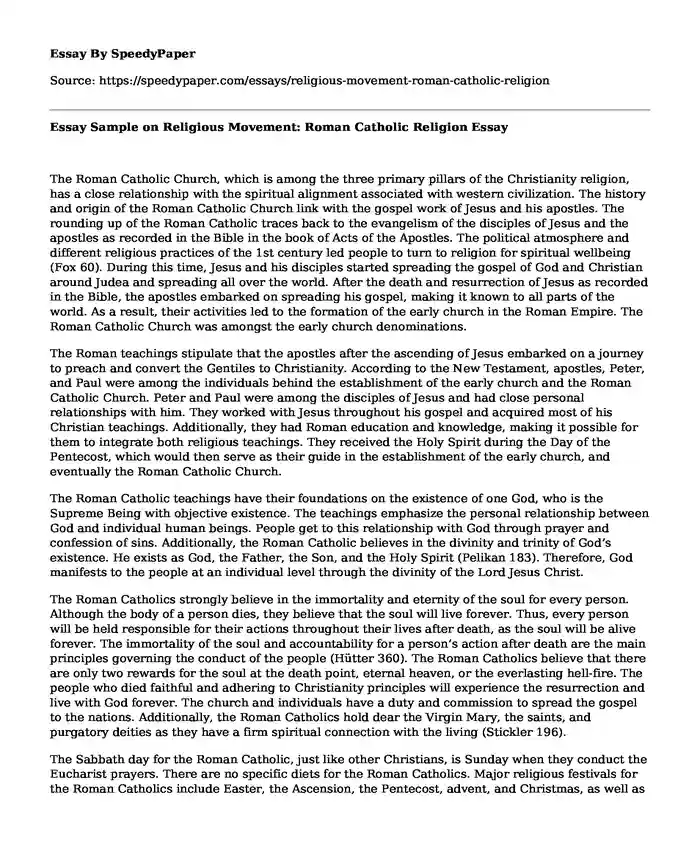
| Type of paper: | Essay |
| Categories: | History Christianity Church |
| Pages: | 3 |
| Wordcount: | 705 words |
The Roman Catholic Church, which is among the three primary pillars of the Christianity religion, has a close relationship with the spiritual alignment associated with western civilization. The history and origin of the Roman Catholic Church link with the gospel work of Jesus and his apostles. The rounding up of the Roman Catholic traces back to the evangelism of the disciples of Jesus and the apostles as recorded in the Bible in the book of Acts of the Apostles. The political atmosphere and different religious practices of the 1st century led people to turn to religion for spiritual wellbeing (Fox 60). During this time, Jesus and his disciples started spreading the gospel of God and Christian around Judea and spreading all over the world. After the death and resurrection of Jesus as recorded in the Bible, the apostles embarked on spreading his gospel, making it known to all parts of the world. As a result, their activities led to the formation of the early church in the Roman Empire. The Roman Catholic Church was amongst the early church denominations.
The Roman teachings stipulate that the apostles after the ascending of Jesus embarked on a journey to preach and convert the Gentiles to Christianity. According to the New Testament, apostles, Peter, and Paul were among the individuals behind the establishment of the early church and the Roman Catholic Church. Peter and Paul were among the disciples of Jesus and had close personal relationships with him. They worked with Jesus throughout his gospel and acquired most of his Christian teachings. Additionally, they had Roman education and knowledge, making it possible for them to integrate both religious teachings. They received the Holy Spirit during the Day of the Pentecost, which would then serve as their guide in the establishment of the early church, and eventually the Roman Catholic Church.
The Roman Catholic teachings have their foundations on the existence of one God, who is the Supreme Being with objective existence. The teachings emphasize the personal relationship between God and individual human beings. People get to this relationship with God through prayer and confession of sins. Additionally, the Roman Catholic believes in the divinity and trinity of God’s existence. He exists as God, the Father, the Son, and the Holy Spirit (Pelikan 183). Therefore, God manifests to the people at an individual level through the divinity of the Lord Jesus Christ.
The Roman Catholics strongly believe in the immortality and eternity of the soul for every person. Although the body of a person dies, they believe that the soul will live forever. Thus, every person will be held responsible for their actions throughout their lives after death, as the soul will be alive forever. The immortality of the soul and accountability for a person’s action after death are the main principles governing the conduct of the people (Hütter 360). The Roman Catholics believe that there are only two rewards for the soul at the death point, eternal heaven, or the everlasting hell-fire. The people who died faithful and adhering to Christianity principles will experience the resurrection and live with God forever. The church and individuals have a duty and commission to spread the gospel to the nations. Additionally, the Roman Catholics hold dear the Virgin Mary, the saints, and purgatory deities as they have a firm spiritual connection with the living (Stickler 196).
The Sabbath day for the Roman Catholic, just like other Christians, is Sunday when they conduct the Eucharist prayers. There are no specific diets for the Roman Catholics. Major religious festivals for the Roman Catholics include Easter, the Ascension, the Pentecost, advent, and Christmas, as well as the Most Holy Body and Blood of Christ (Stickler 188). Similar to the other Christianity doctrines, the Roman Catholic Church uses the bible as the primary religious text.
Works Cited
Fox, Jonathan. An introduction to religion and politics: Theory and practice. Routledge, 2018.
Hütter, Reinhard. Suffering divine things: Theology as church practice. Wm. B. Eerdmans Publishing, 2000.
Pelikan, Jaroslav. The Christian Tradition: A History of the Development of Doctrine, Volume 1: The Emergence of the Catholic Tradition (100-600). Vol. 1. University of Chicago Press, 2018.
Stickler, Alfons Maria Cardinal. The case for clerical celibacy: its historical development and theological foundations. Ignatius Press, 2019.
Cite this page
Essay Sample on Religious Movement: Roman Catholic Religion. (2023, Aug 13). Retrieved from https://speedypaper.net/essays/religious-movement-roman-catholic-religion
Request Removal
If you are the original author of this essay and no longer wish to have it published on the SpeedyPaper website, please click below to request its removal:
- Essay Sample for You: Louis Armstrong Life and Impact
- Essay Sample on American History
- Free Sample: Summarization and Position Paper Dedicated to the Life of Jesus Christ
- To Any Would-Be Terrorists - The Essay Analysis Example
- Free Essay on How Sex in Marriage Can Increase Spirituality and Belief in God
- Compare and Contrast Essay on Two Western Religions: Christianity and Islam
- Free Essay Example - The Sad Stories Behind The LeftOvers by Erin Whitney
Popular categories




